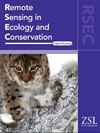利用物种和相机特异性特征推断稀有物种的相机陷阱探测区:一项元水平分析
IF 4.3
2区 环境科学与生态学
Q1 ECOLOGY
引用次数: 0
摘要
相机陷阱是野生动物监测的重要工具。准确估计摄像机的探测区,即动物被探测到的区域,是至关重要的,特别是对于计算未标记物种的种群密度而言。然而,获得足够的检测事件来准确估计检测区域仍然很困难,特别是对于稀有物种。考虑到探测区域受到物种和相机特定特征的影响,当数据稀缺时,可以从这些特征推断出探测区域。我们进行了一项元水平分析,以评估检测事件的数量、物种特征和地点特定变量如何影响有效相机陷阱检测距离和角度的估计。我们回顾了已发表的关于检测区的研究,进行了功率分析来估计准确和精确估计所需的样本量,并使用混合效应模型来测试是否可以从生物和技术性状中预测检测区。我们的结果表明,要实现低于10%的错误率,需要c. 50个检测事件。混合效应模型分别解释了81%和85%的有效探测距离和角度的变化。检测距离的关键预测因子包括体重、右截断距离和摄像机品牌,而角度由摄像机品牌和安装高度预测。重要的是,我们证明了将基于模型的预测与有限的经验数据(少于25个检测)相结合可以将稀有物种的估计误差降低到15%以下。这项研究强调,检测区域不仅可以在使用共享特征的研究中预测,而且可以跨研究进行预测,并且右截断距离是解释栖息地特定可见性的有用度量。这些发现增强了生态研究中探测带的实用性,并支持更好的研究设计,特别是对稀有或研究不足的物种。本文章由计算机程序翻译,如有差异,请以英文原文为准。
Inferring camera trap detection zones for rare species using species‐ and camera‐specific traits: a meta‐level analysis
Camera trapping is a vital tool for wildlife monitoring. Accurately estimating a camera's detection zone, the area where animals are detected, is essential, particularly for calculating population densities of unmarked species. However, obtaining enough detection events to estimate detection zones accurately remains difficult, particularly for rare species. Given that detection zones are influenced by species‐ and camera‐specific traits, it may be possible to infer detection zones from these traits when data are scarce. We conducted a meta‐level analysis to assess how the number of detection events, species traits and site‐specific variables influence the estimation of the effective camera trap detection distance and angle. We reviewed published studies on detection zones, performed a power analysis to estimate the sample sizes required for accurate and precise estimates and used mixed‐effects models to test whether detection zones can be predicted from biological and technical traits. Our results show that c. 50 detection events are needed to achieve error rates below 10%. The mixed‐effects models explained 81% and 85% of the variation in effective detection distance and angle, respectively. Key predictors of detection distance included body mass, right‐truncation distance and camera brand, while angle was predicted by camera brand and installation height. Importantly, we demonstrate that combining model‐based predictions with limited empirical data (fewer than 25 detections) can reduce estimation error to below 15% for rare species. This study highlights that detection zones can be predicted not only within, but also across, studies using shared traits and that the right‐truncation distance is a useful metric to account for habitat‐specific visibility. These findings enhance the utility of detection zones in ecological studies and support better study design, especially for rare or understudied species.
求助全文
通过发布文献求助,成功后即可免费获取论文全文。
去求助
来源期刊

Remote Sensing in Ecology and Conservation
Earth and Planetary Sciences-Computers in Earth Sciences
CiteScore
9.80
自引率
5.50%
发文量
69
审稿时长
18 weeks
期刊介绍:
emote Sensing in Ecology and Conservation provides a forum for rapid, peer-reviewed publication of novel, multidisciplinary research at the interface between remote sensing science and ecology and conservation. The journal prioritizes findings that advance the scientific basis of ecology and conservation, promoting the development of remote-sensing based methods relevant to the management of land use and biological systems at all levels, from populations and species to ecosystems and biomes. The journal defines remote sensing in its broadest sense, including data acquisition by hand-held and fixed ground-based sensors, such as camera traps and acoustic recorders, and sensors on airplanes and satellites. The intended journal’s audience includes ecologists, conservation scientists, policy makers, managers of terrestrial and aquatic systems, remote sensing scientists, and students.
Remote Sensing in Ecology and Conservation is a fully open access journal from Wiley and the Zoological Society of London. Remote sensing has enormous potential as to provide information on the state of, and pressures on, biological diversity and ecosystem services, at multiple spatial and temporal scales. This new publication provides a forum for multidisciplinary research in remote sensing science, ecological research and conservation science.
 求助内容:
求助内容: 应助结果提醒方式:
应助结果提醒方式:


